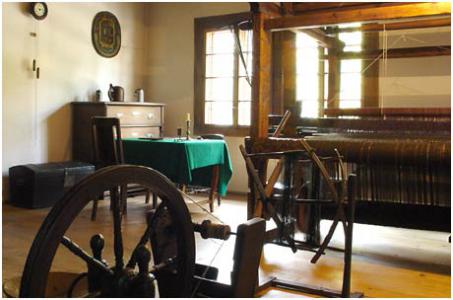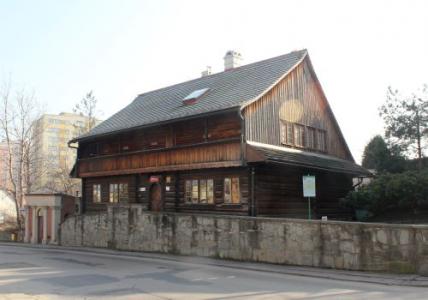The Interior of a Guild Master’s House and his Weaving Workshop
The reconstruction of the interior of the home and weaving workshop owned by a guild master of one of the older guilds, thus a member of one of the highest guild authorities, has been undertaken in such a way as to show what the house would have looked like at the turn of the 20th century, a turning point for artisanal craftsmanship which was rapidly being displaced by mechanical equipment developed in the mid-19th century.
The building is divided into two main parts by a hallway`: the workshop to the left of the entrance and living quarters to the right. The workshop occupies the largest room and displays objects used by the weaver in the course of his work. The large handloom, dating back to the mid-18th century and used to make woollen fabrics, is particularly noteworthy. There are also items used in the preparation and spinning of the warp thread. A section of the room is dedicated to administrative matters, such as guild organisational business and the settling of disputes and quarrels between its members. Documents, guild memorabilia, and an iron chest used as the guild’s strongbox form part of this exhibition. The room also served as the living quarters of the journeyman apprentice and, placed next to stove, we see objects which would have been used by him.
From the workshop, via the front part of the hallway, we reach the kitchen - the focal point of family life. It was here that meals were prepared and served, children played, and the housewife would do embroidery, sew or undertake other craftwork in her free moments. The kitchen was an everyday meeting place for family, neighbours and friends.
The objects in the room fall into two types: alongside the crockery and other kitchen equipment, there are items used in weaving, mainly for auxiliary tasks performed by women and children. These include a spinning wheel and a ‘niddy-noddy’, a tool for making measured lengths of skein from yarn. For comparison purposes, there is a smaller loom from the Bielsko area which dates back to the second half of the 19th century. It was used for weaving linen, a linen-woollen mix or woollen fabrics half the width of those made in the industrial workshop. This loom is used in practical weaving demonstrations for visitors.
Next to the kitchen is the bedroom which was the ‘best’ room in the house, only used during the daytime on special occasions. It is whitewashed and contains veneered furniture from the turn of the 20th century.
The exhibition also features woodcut prints with a weaving theme by Jan Wałach. These are displayed in the hallway.
The Weaver’s House is a unique example of period timber-built town architecture, not only within our own city but also in Poland as a whole. It is the only attempt of its kind at displaying the work of an urban artisan, whose life is completely influenced and shaped by the strong guild to which he belongs.









